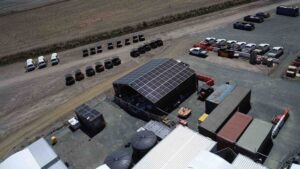Big global investors say they want to invest $1 trillion in renewable energy over the next decade, a new survey has found, but they are scared off from investing in Australia because policy chaos makes it impossible to predict future returns.
Octopus Investments managing director Sam Reynolds, whose firm conducted the survey, says Australia should be doing everything it can do get a chunk of this huge “wall of capital”. Speaking at the Clean Energy Council’s Large-scale Solar Forum, he said the federal government’s obvious antipathy towards renewables was not helping.
“The worst thing is a lot of the big superannuation and pension funds we deal with, they obviously … see that the Australian federal government doesn’t appear fully behind the transition to renewables, doesn’t appear to have a coordinated energy policy that’s working with all the states. And that state based uncertainty and federal uncertainty … makes it tricky for models and that sort of thing.
“If you want to deploy hundreds of millions into a country or into a sector, then you do need the government to be there right behind you,” he said. “That is a massive opportunity if Australia gets this right, and we should be seeking as much of that wall of capital into our renewable energy sector, getting the cost of capital down like it is in Europe.”
The survey found the vast majority (80 per cent) of institutional investors said they planned to increase their exposure to renewable energy over the next decade. Just from those surveyed, Octopus calculated this potential investment was worth around $US800 billion (just over $A1 trillion).
“Decarbonisation is on everyone’s agenda,” he said. “Every pension fund, superannuation fund – AustralianSuper came out the other day saying [it would target] net zero emissions. [So has] HESTA, Cbus, Unisuper, REST Super, Aware Super – these are tens of billion dollar industry funds that want to get into this sector,” he said.
Also speaking on the panel, David Dixon, a renewables analyst with Rystad Energy, said negative prices were a growing problem for the utility-scale solar sector due to excess capacity during the day. He said the number of hours of negative prices per month had leapt from 20 hours in 2018 to 100 hours in 2019, and 200 hours in 2020.
More large batteries would help solve this problem, allowing the excess capacity to be stored and used when demand picks up. Dixon said the total pipeline for utility lithium ion battery had gone from 2.3 gigawatts in 2018, to 29 gigawatts today. But turning commitments into actual projects was not a given.
“So it’s, it’s growing by an order of magnitude essentially, in the past three years alone. Are these financial commitments? The short answer is no, it’s just, it’s just intentional.”
Edify Energy CEO John Cole, also on the panel, said using batteries just for the purpose of arbitrage was so far not proving enough to make them economic, and other uses would need to be developed. “I think batteries for me I’d describe as conviction investing, because the economics as of today are a challenge.”
Reynolds welcomed Energy Australia’s decision to close 1,480MW Yallourn coal plant in Victoria four years ahead of schedule in 2028, and replace it with a a 350MW battery. He said this would boost demand for more renewable capacity, pointing out the battery itself would not replace any generation capacity.
“Batteries don’t produce electrons. They shift them around, but they don’t produce anything. So it has a benefit, but there’s still a lot of work to do to replace 20 per cent of Victoria’s generation over the next six, seven years.”
Despite concerns about the federal government lack of support for renewables, the panellists were by and large optimistic about the future for utility-scale solar and renewables in general.
“I think we’ll see Australia actually grasp the opportunity that’s staring it in the face to become an energy superpower,” said Cole.









